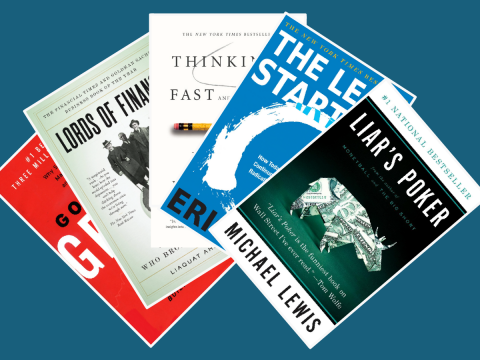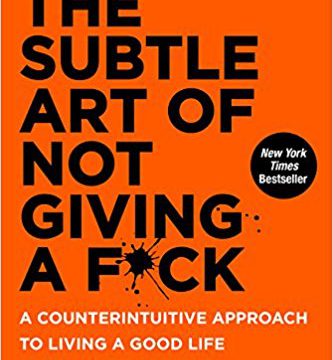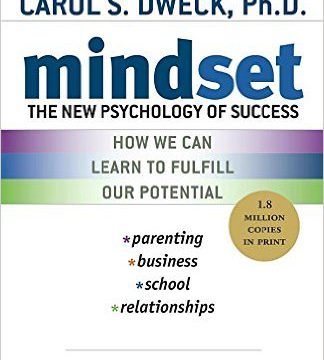Fifty great options to immerse in the psychology book


First of all, reading is absolutely unique activity, only after reading a book you can become different person or your life views and priorities may change greatly. With the correctly chosen book you can save yourself from depression or to motivate for some actions. Good book, especially psychology book can significantly expand the boundaries of your consciousness and help to understand people and yourself better. In this list a great collection of real “masterpieces” from famous authors is presented. Among these books you will find different types of books, some of them are more scientific, some are less. Pick the most suitable for you or read them all and never stop progressing! These books will tell you about all secrets of human behavior, persuading and making friendship. Let’s start!
The Invisible Gorilla

Each of us at least once in a lifetime has been a victim of our inattention. Accident on the road, stolen from the bag purse, stains from coffee on a new suit … And how much interesting we lose sight of! Why don’t we notice what is happening right under our noses?
We do not just see (or remember or hear) something that is not really there – we are absolutely convinced that our vision is true. These and similar phenomena are called illusions by our authors of our intuition. This book is about how illusions are born, to what anecdotal or tragic consequences they lead and how to overcome them. You will become participants in amusing and serious experiments conducted by the authors of this book. And you will be able to see how often people act and make decisions, being in reality distorted by their consciousness.
Why We Buy

The book “Why we buy” is based on data that was collected as a result of long-term observations of buyers in various shopping centers, department stores and supermarkets in America. Paco Underhill, called the San Francisco Chronicle newspaper “Sherlock Holmes of the World of Commerce,” reveals in the pages of his book the struggle between sellers, marketing specialists and increasingly competent buyers for the right to control the situation in the trade. Trying to find out what motivates modern consumers, Underhill explains many of the trading phenomena that often go unnoticed for both buyers and sellers. Here are some of them:
- how a successfully delivered basket can significantly increase the level of sales;
- what is the phenomenon of “touch from behind” and how it affects the efficiency of the store;
- how working women contributed to the change in the design of supermarkets;
- what type of advertising and packaging products can turn a shopper into a real buyer. For the specialists in the field of trade and marketing, the book “Why We Buy” will become a new guidebook and will teach them how to adapt to the constantly changing behavior of buyers. The rest of readers will be interested in the new original look at their favorite pastime.
Sleights of Mind
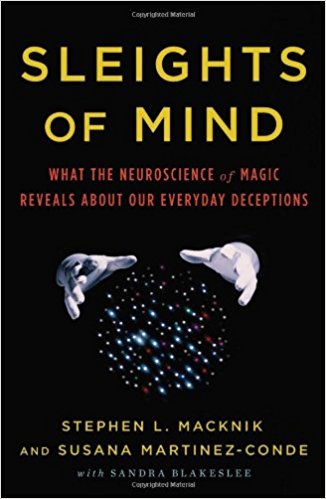
Stephen McNick and Suzanne Martinez-Conde are the founders of the new discipline of neuro-magic. They convinced some of the most prominent illusionists of our time to let scientists explore their techniques of misleading our brains.
Magical tricks work because our attention and consciousness are set up so that they can be distracted, “hacked”, in the words of computer scientists. Good illusionists use the congenital properties of our mind and brain against us in the form of mental jujutsu.
By understanding how illusionists get into our brains, we will be able to figure out how the same cognitive tricks work in advertising, negotiations and interpersonal relationships. Having realized how magic works in the brain of the viewer, we will be able to understand the neural basis of consciousness in itself.
Sleight of the mind is the result of many years of study of magic and the application of its major principles in the behavior done by the authors of the book. Now we can say that illusionism and magic can show how our brain works in everyday situations. For example, if you purchased an expensive item that “was never going to buy” – it means that the seller was able to create the “illusion of choice” – a key technique of focus.
The application of the results of neuro-magic goes far beyond the limits of normal behavior. Each new study contributes to various areas of life – from the diagnosis of autism to education and marketing techniques. The books on the real examples tell us about the key links between magic and the mind.
Strangers to Ourselves

This book has started for many readers a serious way to the subject of the unconscious. The book is created more for researchers of higher education and for psychological institutions. However, if you do not go deep into the first few chapters, then, in general, almost everyone will be able to find a large number of interesting ideas and strong research. In the many lists of the best psychological books you will find this one. We do not recommend you to surf the Internet searching for its description, just start reading and you will not stop.
How to Win Friends and Influence People
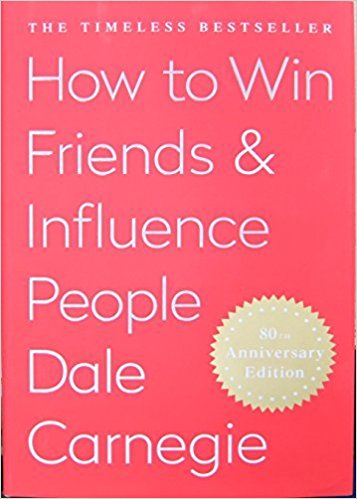
For more than seventy years already, Dale Carnegie’s books have been in constant demand among readers. So what is the main secret of his books? First of all, in the style of the presentation – it is specific, laconic and, thus, accessible to any reader, you can be a manager, a marketing specialist, an insurance agent or a housewife, this book is available for understanding by everyone. Carnegie’s books teach a person to believe in their own strengths and develop business qualities, get rid of complexes by developing the art of communication and help to earn more. They are also a practical guide to acquire good oratory skills and learn the psychological principles of communication between people. The teachings, instructions and advice of Dale Carnegie since the first publication of this book have helped thousands of people become well known in society and successful in all beginnings.
The 48 Laws of Power
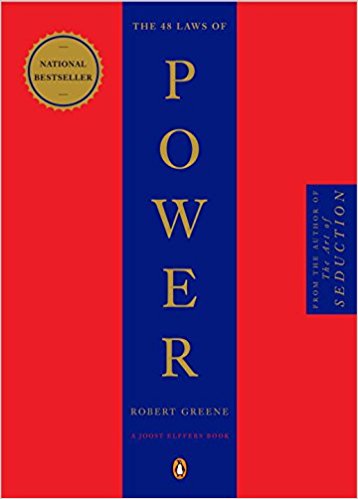
This is the most amoral, the most scandalous, the most cynical … and the most truthful book about power, starting from simple, everyday power to presidential. Henceforth, having learned the hard and cruel laws of behavior in power, having brilliantly formulated and backed up by the most interesting and unexpected historical facts, you can easily recognize what stands behind those or other words and actions of “small” bosses and what they are trying to hide so carefully.
“48 laws of power” is a handbook for those who wish to master the science of managing people, to unerringly use their weaknesses to achieve your own power.
The Tipping Point
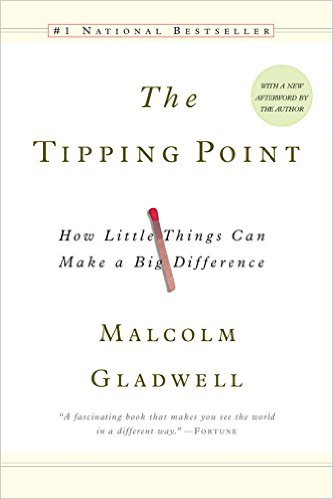
Quotation “We are all in the soul of supporters of gradualness, and our expectations are based on a measured flow of time, but the world at a turning point is a place where the unexpected becomes possible, where radical changes are more than probability. And this is in spite of all our ideas – fact” (Malcolm Gladwell)
What is this book about?
This book is about ideas, goods, information and behaviors that are spreading just like viruses. The author seeks to answer two main questions: why do some ideas, behaviors or products cause epidemics, while others do not, and what can we do to evoke beneficial epidemics and consistently manage them.
Why the book is worth reading?
This book became an international bestseller and was published in 12 countries of the world. It makes you look at the world completely from the other side and learn something new about the usual things. There is no moralizing and common truths, but there are intelligible explanations of the phenomena characteristic of today’s life.
Who is this book for?
For all who are interested in how the fashion is generated, how books of unknown authors become bestsellers and how the crowd phenomenon and many other mass phenomena arise.
Beyond Culture

The perception of space also has specific features that depend on culture. E. Hall was one of the first researchers in the field of studying the spatial needs of man and established significant differences between them in representatives of different cultures. He introduced the scientific term PROXIMIC which implied the doctrine of the use of space by people as a cultural artifact, organizational and communicative systems. The study of E. Hall, as well as the majority of culturologists, dealing with intercultural differences, represented an analytical examination of different cultures. The question arises of the number of parameters necessary to cover such a complex phenomenon as culture. This book is quite specific and have different reviews, but it is popular in the world of psychology and definitely worth reading.
Situations Matter
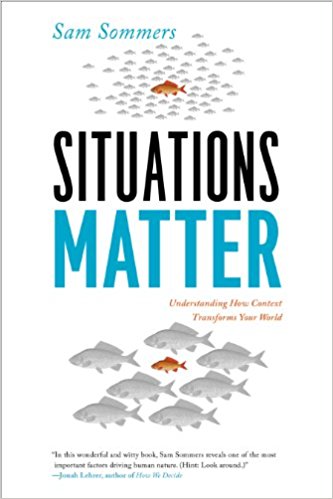
This book is not from the list of “books for everyone”, it’s quite specific but if you like the way author present his thoughts and researches to reader, you will fall in love with this book immediately. This book make you think about simple things that you face with every day and look at them on the other side. If you are a keen of neuroscience and psychological researches and at the same time interesting style of writing, you should pay your attention on this book. Various unexpected questions and shocking results of researches will not leave you indifferent while reading this book.
The Willpower Instinct: How Self-Control Works
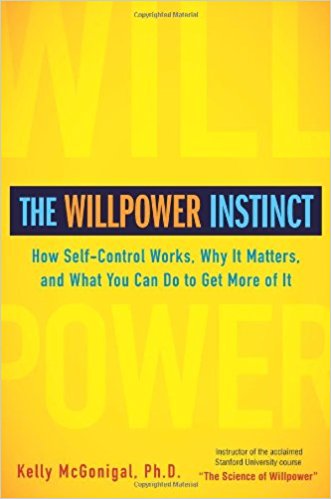
Willpower distinguishes champions from ordinary athletes and, as it turned out, it is exhaustible. This unique resource of our body is considered in a large book about what is willpower, how it can be developed and strengthened.
As in most other books about the process of thinking and analyzing how people think, the book provides information that we have the brain of a reptile, a mammal and a human. The same neocortex that allows us to perform reasonable actions and take care of “new” ourselves in the future. Willpower is a key factor that allows us to save money, care about our health and survive in groups. As it turns out, it is important to be able to forgive yourself and not be dissatisfied with your weaknesses. For this fact as for other conclusions cited in the book, references to relevant scientific research are given as evidence. This book is a treasure trove of valuable information about how our brain and decision-making system works, so it will be useful not only for those who want to develop volitional skills, but also for those who want to become a good marketer, negotiator or seller.
The Psychology of Attitude Change and Social Influence
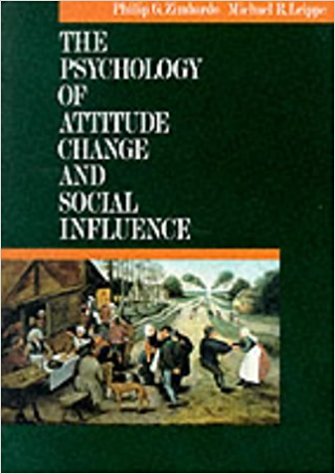
In front of you there is a work of living classics of psychological science. This book is a publication that can be used as a basic or additional manual within the framework of the course on social psychology. For teachers of sociology, communication theory or business, the book will help when teaching such reading courses as “The impact of the media,” “Propaganda and the media,” “Social influence in small and large groups,” “Fundamentals of advertising” and so on. The book includes materials directly related to the problems of each of these disciplines.
Designed for the student audience, the book will be interesting and informative for graduate students-psychologists, sociologists, researchers of communicative processes. The abundance of examples and ways to apply the theories in it in practice will help to reveal new horizons of the specialty with which you will link the future career.
The Person and the Situation

This option is one of the most important psychological works of the last decade. It examines the main theoretical ideas of social psychology, analyzes the dramatic experience of practical solutions to social problems. The focus of the authors – famous social psychologists – is the power of the situation over human behavior, its psychological mechanisms and applied consequences. It is a great choice for students and teachers of higher educational institutions, for all who are interested in socio-psychological theory and its application in practice. Its authors are convinced that it is practically impossible to predict human behavior in a specific new situation based on observations of this person’s actions in other situations or on the basis of knowledge of the features of his personality.
Out of Character
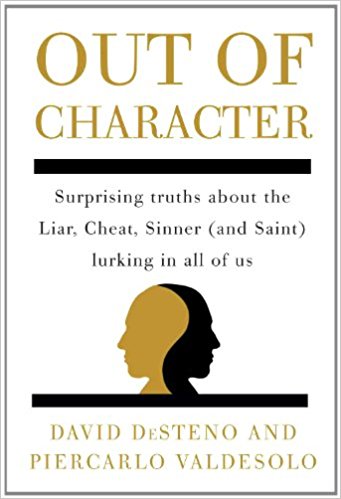
One more option that you really MUST read is this book. Here you will find many interesting researches and observations connected with such common people as we are. You can be a bit shocked while reading this book by understanding that in the majority of situation described in it you will act the same way and do the same things. Author very interestingly tells us about the impact of many different situations and events in our life and how we change under their influence. Our strong and weak sides are revealed in this book. You will appreciate this book if you are interested in our behavior, personality and character.
Blink
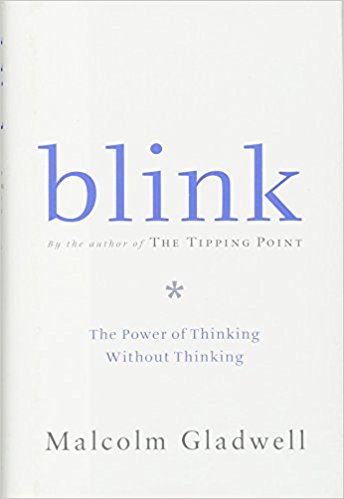
The police shot an innocent man. Experts for a year of research could not establish the falsity of the statue. On the post of President of the United States in 1921, Warren Harding was elected – a mediocre and unlucky politician. Why did these fatal errors occur? Was it possible to avoid them? In his fascinating book, The Power of Instant Solutions, Malcolm Gladwell, author of the best-selling book Breakthrough Moment, analyzes the decision-making process. On rich material from the field of art, science, design, medicine, politics and business, he reveals the patterns of unconscious decisions and analyzes the factors that distort this process. The book will be of interest to psychologists, political scientists, marketers – all specialists whose success depends on the ability to make important decisions (sometimes in times of acute shortage of time), as well as a wide range of readers interested in the latest achievements of psychology.
Originals: How Non-Conformists Move the World
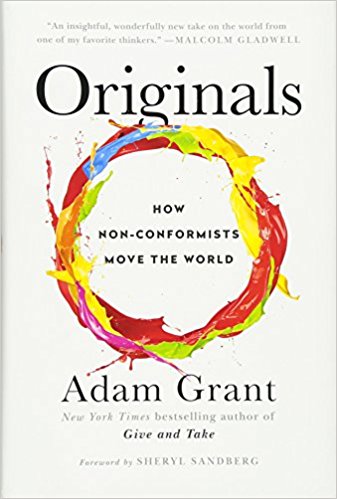
In the current book author considers the history of Dean Kamen, one successful innovator, who failed with the Segway scooters, but achieved great success with medical equipment. Moreover, even a well-known innovator, like Jobs, was offered for free to bring the brand to the market, and without results. How could these rock stars lose? Grant argues that success in one area does not guarantee success in any other. And often arrogance dazzles the possible prospects. But this is only one of many examples by which the author illustrates his view of things. The author also considers the question of murderous mediocrity, which is also called the conservatism of the middle status conservatism. The more you are familiar with a specific industry, the less creative you are, says Grant. And working as an average middleweight manager, you are less likely to “shake the boat” and change something. However, at the lower or higher levels of the corporate ladder, you can always go beyond the traditional routine.
Incognito: The Secret Lives of the Brain
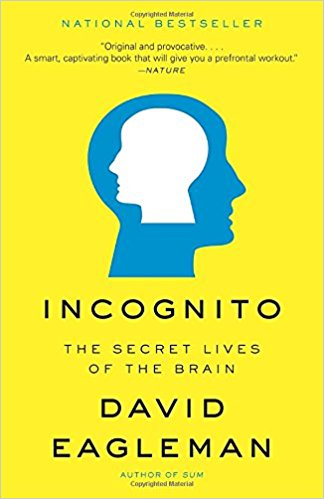
David Eagleman, the famous American neurobiologist, the author of the world’s best-selling books, the creator and presenter of the international television series “The Brain”, invites readers to an exciting journey to the origins of their own personality, into the depths of a mysterious body whose secrets began to penetrate science very recently. Who are we? How do we move? How do we make decisions? Why do we need other people? And most importantly, what awaits us in the future? What discoveries and opportunities does an incredibly powerful brain promise to an individual who has been endowed with its evolution? It is possible that in the near future plasticity of the brain, which for millions of years allowed people to adapt to the changing conditions of the surrounding world, will help them to free themselves from the biological basis and make the biggest leap in the history of mankind – the transition to the era of transhumanism.
Everything that happens in your life – from short conversations to culture in a broad sense – forms the microscopic features of your brain. From the point of view of neurology, the person you are is determined by where you were. The brain is an indefatigable werewolf, constantly rewriting its chains, and, since your experience is unique, the structure of extensive neural networks is also unique. And because these networks continue to change throughout life, your personality is like a moving target: it never reaches its final goal.
What Makes Your Brain Happy
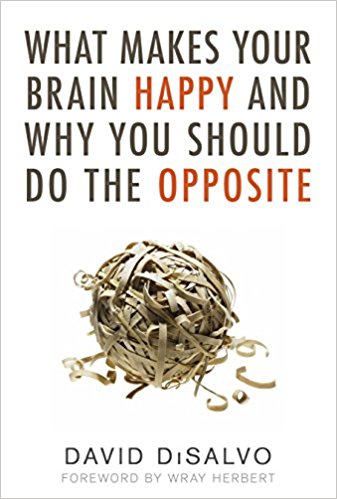
David di Salvo is a scientist, teacher and author of the bestselling book “Quick solutions do not lead to success.” Understand what your brain wants and do it the other way around “, translated into 10 languages in six months and made popular all over the world. His articles are published by such magazines as Esquire, Salon, Scientific American Mind, Forbs, The Wall Street Journal, Mental Floss, Psychology Today. Why do we knowingly choose what agrees with our immediate desires, but puts an end to far-reaching goals? Why do we willingly succumb to temptations, which they so persistently tried to refuse? Why do we tend to give meaning to ordinary coincidences?
The fact is that our brain does not like to strain. He likes ready-made schemes, familiar patterns, certainty and predictability. Going beyond the usual – the stress, which he tries to avoid in every possible way. Our brain will be absolutely “happy” if we allow it to work “on autopilot”.
The author examines in detail all the mistaken strategies of the “happy” brain and gives readers valuable advice and recommendations. “Our task is to learn how to think and, if necessary, act contrary to the natural inclinations of the brain,” Di Salvo believes.
You Are Not So Smart
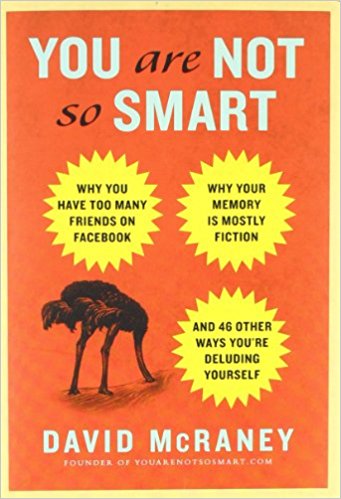
Current book is about the triumph of self-deception, about exposing illusions about oneself, about the constant war in our brain, about the manifestations of irrational thinking, about the fact that we regularly deceive ourselves, because we do not want to admit: we are not so clever … Forty-eight chapters of the book represent 48 kinds of logical prejudices and delusions, and each chapter is presented really excellently!
Why this book is unique?
The peculiarity of the book is its style. Such complex topics as “cognitive distortions and cognitive dissonance”, “heuristic errors”, “logical errors and logical tricks” are filed easily, simply and very clearly. That’s the essence of the journalistic talent of McRainy: about complex things – accessible and fun. The author makes curious inserts, tells anecdotes, but this is not a frivolous thrill, but a serious study. The book is read in one breath!
Who is this book for?
For those who want to get acquainted with their own irrationality, and those who still believe in their own logic. It’s time to be a bit surprised at yourself.
It’s a really fascinating book. As you begin to read the chapter after chapter, you will begin to change your view of yourself. And soon you will understand the nature of your delusions. You are warned, so you are armed!
Brain Rules: 12 Principles for Surviving and Thriving
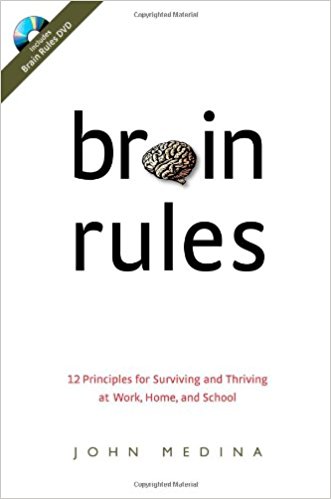
What is the current book about? Did you know that 26 minutes of sleep can increase your productivity by 34%? That the brain in a dream does not stop its activity and is even more active than during periods of wakefulness? That men and women perceive reality and make decisions in completely different ways? We know very little about how our brain functions, and we do not take into account the peculiarities of its work in our daily life and professional activity. Meanwhile, this knowledge can help us work more productively, memorize more, better learn and conduct effective negotiations and presentations. Professor John Medina formulated twelve principles of the brain, each of which we can use in everyday life. For example, every ten minutes the brain needs a small break to continue to perceive information: and the author himself skillfully uses this rule, illustrating his book with stories and examples.
After reading this book, you will learn:
- How sleep and stress affect our brains;
- how we learn;
- that multitasking is a myth;
- how physical and intellectual exercises reduce the risk of disease;
- why new information is quickly forgotten and how to avoid it.
Who is this book for?
For all who want to live and work more effectively.
The main peculiarity of the current book is combination of popular science topics and manuals for personal development.
Redirect
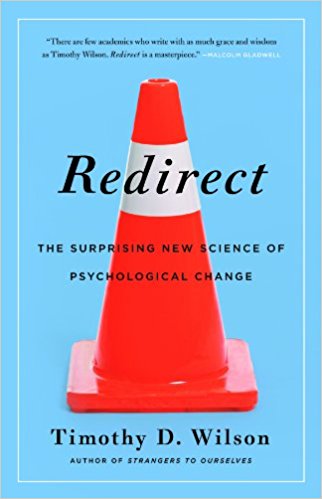
Author describes a large-scale and impressive study of how stories can influence people’s behavior in the long term. Wilson forced people to rewrite their own stories. This technique he called “editing stories.” It is used to treat people with post-traumatic stress and to help difficult adolescents. The technique is so simple that it’s hard to believe how dramatic the changes it causes.
When a person writes a new story telling who he is, why he does so, and not otherwise, in what relations he is with other people, consciously and unconsciously he begins to make decisions and act in accordance with this story.
But what if you can’t force a person to stop, think and write a new story? Does this mean that we will not be able to take advantage of the power of the impact of the stories? Fortunately, nothing prevents us from inventing a story for a person, which gives almost the same effect.
This book is just a masterpiece about our behavior! If you want to know how to form permanent and stable changes in your behavior, or in the behavior of those you know, this book is compulsory for reading. Wilson covers modern and, often, very amazing studies that are conducted on the subjects and they are actually changing, changing their childhood behavior. This book will tell you what works, and does not work, based on specific research and experiments.
Sway: The Irresistible Pull of Irrational Behavior
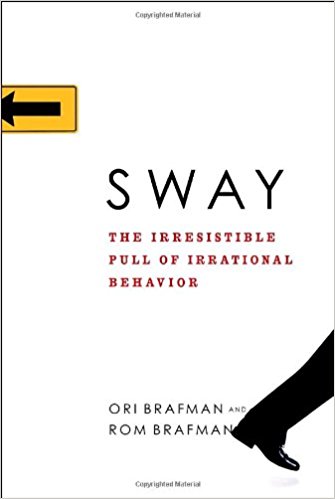
Who among us did not happen to buy expensive and unnecessary goods, tempted by effective advertising? Invest hard-earned money in a fraudulent enterprise? Take a bad credit at the bank? Choose a travel agent much more expensive ticket than the one we can afford? Then we lament and say: “If you knew in advance!” But … did not we know how to proceed? Why did everything go wrong? What makes us do illogical things again and again? And most importantly – how to deal with this?
Mindfulness

Have you ever said “excuse me” a dummy in a store or wrote out a check in January with the date of the previous year? Most of us will probably say yes, but these from the first view small mistakes, as Ellen Langer believes, are the top of the iceberg of our unconsciousness.
Langer is a professor of psychology at Harvard University, and her studies of the problems of stagnation of consciousness led to a number of discoveries related to mental flexibility, or awareness. Over the years since the first publication of the book in America, Helen Langer and her team created a unique concept of awareness fully adapted to modern life.
Langer’s theory has been successfully applied in a number of areas, including healthcare, business, training, and problems of youth preserving. In her preface to the 25-year anniversary edition, Dr. Langer talks about his famous experiment with maids, about experience with visual acuity, with the “time machine” in a nursing home and says that the main discoveries in the field of awareness are yet to come.
The Optimism Bias

We are born to become optimistic, instead of realistic looking at the world? In the book Tali Sharot talks about a new study suggesting that the human brain is set for a positive wave, and that such a worldview can be equally dangerous and useful. The propensity to optimism is observed among residents of different countries, men and women, children and the elderly. Is it good for us? There is an opinion that those who expect less are happier. This theory is incorrect, and to that there are three confirmations. First: the person will achieve the goal or not, but those whose expectations are overestimated, feel better than those from whom they are understated. This is because the state of a person, whether he was fired from work or was made a worker of the month, depends heavily on how he treats this event. Second: regardless of the outcome, the very process of waiting makes us happier. That’s why, for example, people like Friday more than Sunday. Curiously: Friday is a working day, and Sunday is a day off. People prefer Friday, because it brings with it the joy of waiting for the coming weekend. Optimists expect more in the future, and this expectation makes their life better. So, optimism changes subjective reality. Our expectation of the future changes how we see this coming. But optimism also changes the objective reality. It acts as a prediction that is fulfilled. This is the third proof that understated expectations do not make us happier. Experiments show that optimism helps success in science, sports, politics. It’s amazing: optimism has a positive effect on health, reducing the level of anxiety and stress.
Obedience to Authority
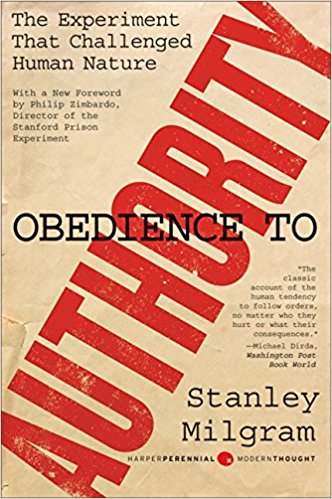
What can a good citizen do when obeying the order?
Reflections on tens of thousands of people in fascist Germany, sending their own kind to death, simply fulfilling their duty, pushed Stanley Milgram to the idea of a provocative experiment. The behavior of the subjects in the course of different variations of the experiment invariably confirmed Milgram’s terrible conjectures: some participants severely “punished” others without using their right to refuse. The paradox is that such virtues as loyalty, discipline and sacrifice, which we so appreciate in a person, bind people to the most inhuman power systems.
But since the Nazi death camps, the nature of man has not changed. That is why the relevance of the concept, which the experiment confirms with terrible conviction, can be disputed, but it is dangerous to underestimate. Milgram’s famous experiment, which initially provoked protests and mistrust in many, was later recognized as one of the most ethically significant studies in psychology.
The Lucifer Effect: Understanding How Good People Turn Evil
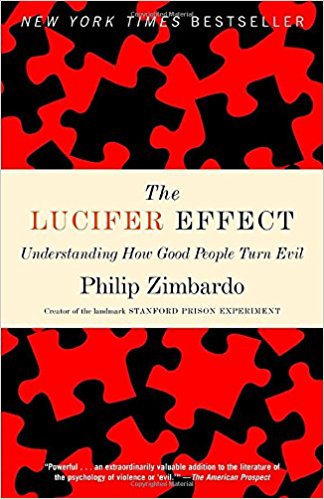
The book is not about fighting good against evil. Zimbardo returns to his famous Stanford prison experiment, from where he started his study of the nature of human evil. At the end of the book his program about resistance to undesirable influences sounds reassuring and quite confident.
Why the book is worth reading:
- Deep analysis of all possible forms of violence and cruelty, indicating the reasons for their emergence and development.
- Able to convince that almost every inhabitant of the planet can suddenly turn from a mere mortal into a villain.
- The book runs counter to the traditional American policy of destruction and capture
- Cold-blooded conclusions about what and how can prove stronger than the will of man and suppress his resistance.
- Behaviorism as the weakest argument of psychologists to justify crimes.
- What is heroism? An unconventional approach to behavioral attitudes that come into conflict with the system and power. Contrasts of heroism.
Who is this book for?
For lawyers, political scientists and historians. And also for all those who are not indifferent to the fate of mankind, more and more slipping into the abyss of evil and violence.
Social Engineering: The Art of Human Hackingl
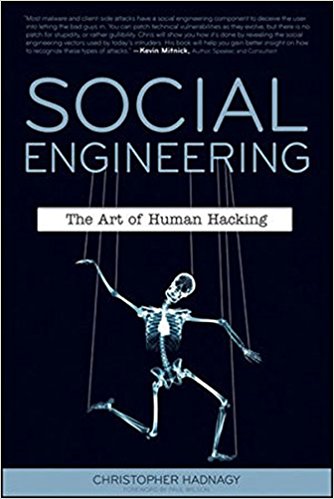
Trick, when a hacker attacks not a computer, but a person working with a computer, is called social engineering. Social hackers are people who know how to “crack a person” by programming it to perform the necessary actions.
The book describes the arsenal of fixed assets of the modern social hacker (transactional analysis, neurolinguistics programming), examined and analyzed in detail numerous examples of social programming (the science that studies the programming of human behavior) and ways to protect against social hacking.
The book will be useful to IT professionals, employees of enterprise security services, psychologists studying social engineering and social programming, as well as to PC users, since they are often chosen by social hackers as the most convenient targets.
Mistakes Were Made
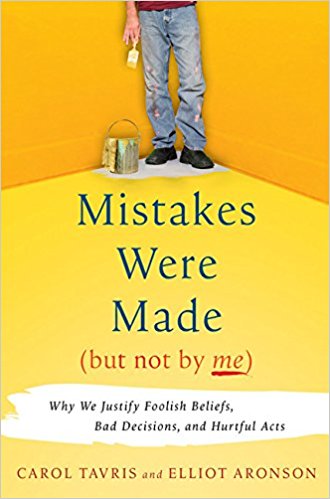
I love books that explain a lot. This one is about self-justification. About the amazing inner world of man, about cognitive dissonance, about the mechanisms of self-defense. In general, this is a book about human blindness. When we commit acts that are contrary to our convictions, or our own self, an unpleasant sensation arises – cognitive dissonance. And we do our best to compensate for it. We correct the history of events in our heads, forgetting the discordant memories and fixing ourselves on the confirmers. Sometimes, in order to assure ourselves of the correctness of our actions, we perform reinforcing deeds, which deeper deceive us. We ignore and adjust to our version all the refuting facts, even scientific.
Surely you have often noticed how the politicians caught red-handed, are saying the most ridiculous arguments in their defense. When it is already obvious to everyone that they have committed a monstrous mistake. At such moments involuntarily you think about – or they think we are idiots, or they really live in some sort of their own world and believe in all this nonsense. By the way, the title of the book is a popular form of removing responsibility for wrong political (and not only) decisions.
Knowing these processes will protect yourself from committing many mistakes.
The Secret Life of Pronouns: What Our Words Say About Us
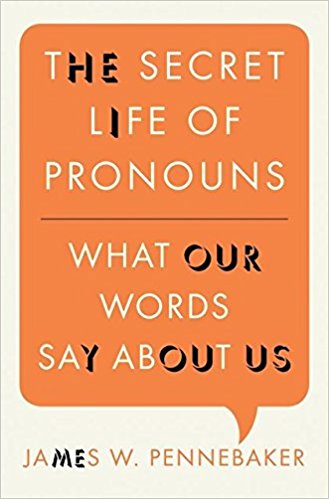
James Pennebaker: “I have never been specially interested in the analysis of speech and text, I met this in the 80s-90s when we, psychologists, studied groups of people whose lives consisted of some tragic moments or serious illnesses. We wanted to know what effect their physiological health would have on the narration or description of written psychological experiences of psychological upheavals. Will they get better by doing it. Four days in a row, within 15 minutes, one group described their misfortunes, the other – some minor events in their lives. Then we wanted to somehow analyze what was written, but we could not do it until our students created a special computer program that showed how often both groups used each part of the speech. And not even from the main ones, but, say, prepositions, conjunctions, words like “except”, “but”, “excluding”, “no”, “never”. So the frequency of using some of these words predicted the success of recovery. It became clear later: they had less go to doctors or stopped doing it at all, they were better at studying. The irony is that I was never interested in linguistics or analysis of the text and literally I had to open this world for myself”.
The Buying Brain

If you think that such term as “neuroscience” is something super scientific and normal person doesn’t face with it often, you are completely mistaken. World famous prosperous companies achieved their tremendous success by playing with our subconscious mind. They pay a great sums of money for the specialists in this area to create the most attractive design, the most popular brands and the most attractive products. We will never know why we purchased stuff that we don’t need and especially, that we can’t afford. We do it subconsciously without suspecting anything. This book tells us about the newest technologies in the neurosciences and different researches in this field. It even can be called not a book, but a guide which will tell you all secrets of human brain and way of making decisions. If you want to know why you like some things and don’t like others, why you purchased this good and not that one, which is cheaper or better, this book is for you.
The Compass of Pleasure
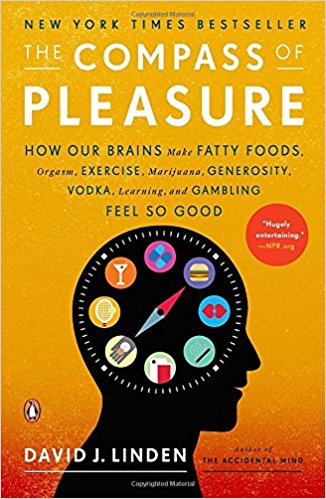
The history of mankind can be considered as a chronicle of desires: conscious, unfulfilled, satisfied. The desire for pleasure in various forms has always been the strongest motivating force that can manage both the destinies of peoples and the lives of individuals. This fact tried to be comprehend by Epicurus and Nietzsche, but only thanks to recent achievements in the field of neurobiology it began to be studied seriously. David Linden’s book tells of the newest researches that helped to understand how the neural chains of pleasure in the brain are activated by the weak and, surprisingly, the strong sides of human nature. Linden explains the latest achievements of science with the help of fascinating stories from life, showing the hidden mechanisms of pleasure-giving actions and how they grow into addiction. With the help of this book, you will be able to understand the essence of your desires better and to avoid different traps. The book is written in an easy and accessible language, with fair humor, and will be very interesting to a wide range of readers.
Brandwashed: Tricks Companies Use to Manipulate Our Minds
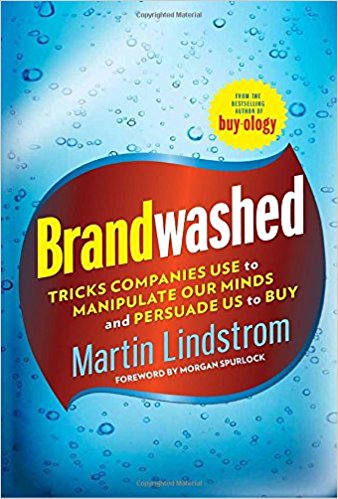
Did you know that marketers can advertise their products even to children in the womb? Do you know how the marketing campaign of the popular brand of vodka changed the image of alcohol consumption in the whole country? Do you know how retail chains inflame panic and fears of epidemics and catastrophes to make money on it? Do you know that dependence on a mobile phone is stronger than alcohol and drug dependence? But Martin Lindstrom knows – and tells in his new book about how companies “reflash” our brains to put us on shopping and consumption.
You will ask for who this book fits better? For all who follow the new methods of marketing and advertising. And for everyone who tries to resist them. This book is an effective weapon in the hands of both opponents: both marketers with advertisers, and ordinary buyers (that is, us with you). Read it will be interesting and useful to us all.
Martin Lindström knows the branding of big corporations from the inside – he is now armed with this knowledge, exposing the most striking and intimate secrets.
Companies, marketers, advertisers have become even more insidious, resourceful and dangerous. They scan our brains and gain access to our most intimate fears, dreams, weaknesses and desires. They study the electronic “fingerprints” that we leave whenever we use a discount card, pay with a credit card or browse the goods on the Internet, and then, based on this information, we create proposals tailored to our unique psychological profile. They steal information from our computers, mobile phones and even from Facebook profiles and skip it through complex algorithms to predict who we are and what we can buy.
The Paradox of Choice: Why More is Less
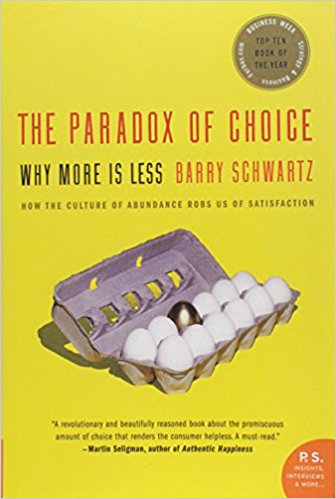
The book is really GREAT. Reading it, many of the problems associated with an excessively large choice in the field of consumption become absolutely clear. The author of this book gives his example of jeans, which he so long chose in the store, that at the end, when he was already determined with a choice, was not particularly happy with his purchase. We can observe the same thing everywhere, while manufacturers give us to understand that by giving us a greater range, they give us freedom of choice, but this is just an illusion, the victim of which we unconsciously become, trusting and naive buyers. The author slowly and methodically reveals these mechanisms and gives us practical advice to again not become a victim, the so-called “freedom of choice.” This book is one of those after which you start to think absolutely differently and evaluate your consumer habits and behavior patterns in terms of how happy they are making you.
The Branded Mind
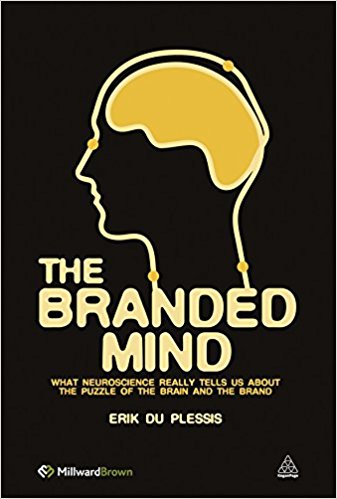
Advertisers talk a lot about the importance of creating an emotional response from people. However, they rarely explain what exactly this response is and why it is so important. Of course, it is not easy to define the emotional response. An additional complication is the lack of clarity regarding such terms as “emotional”, “rational”, “subconscious”, etc. Nevertheless, a review of modern ideas about how emotions control our thinking shows that emotions are both a more and less important factor than most advertisers think. In addition, attempts to classify the response to emotional and rational are often meaningless, since this contrived dichotomy is false and misleading.
The theme of using emotions in advertising, as a rule, is associated with certain types of videos: those in which touching and heartbreaking episodes are depicted, charming babies or touching fuss of puppies. Too often an emotional response to advertising is understood as a reaction that causes tears or smiles. But in fact, any advertisement causes an emotional response, because everything that we encounter in life generates an instinctive emotional reaction. Literally everything. Therefore, from this point of view, emotions are more important than most advertisers think. As explained in the current book The Branded Mind by Eric du Plessis, emotional reactions are an integral part of our brains necessary for our survival.
All efforts in the field of advertising are reduced to an impact on the consciousness of the consumer. To attract attention, impress, put aside in memory is the goal of any advertising appeal. To achieve this, you can act on the whim, and you can turn to scientific research and experience It is about them said in the book of Eric du Plessis
Neuromarketing: Understanding the Buy Buttons in Your Customer’s Brain

This book is about how brain research helps to attract the buyer’s attention and increase sales. The authors offer effective techniques for creating memorable presentations that can influence potential customers, make them take an emotional decision and rationalize it. “Training in neuromarketing” is designed to increase the ability of companies to influence the consciousness of consumers and teach them how to create effective marketing strategies.
Recipe for success:
After reading the book, you surely:
- will make more deals,
- will understand how consumers make a purchasing decision,
- will start to quickly make impressive sales,
- will create more effective marketing strategies,
- you can create powerful, unique and memorable presentations that have a long and lasting impact on potential buyers,
- radically improve your ability to influence others.
Readers are constantly encouraged to reflect, prove, and offer, it is in this dialogue that the neuromarketing methodology is manifested. All reflections are confirmed by real examples from the life of successful projects that will give you a clear understanding of the methods of their implementation. The structure of the book is very carefully thought out: there are many items of the bulleted list, subheadings, graphics and diagram. Each chapter ends with the section “Must be remembered”, which once again focuses on the key aspects with which you go to further study the secrets of neuromarketing.
Patrick Renvoyze and Christophe Morin are considered to be the founders in the new field of neuromarketing. In less than two years, they became the main speakers at many top-level marketing and trade events and, accordingly, top experts from Vistage, the world’s largest organization of senior executives.
Brainfluence: 100 Ways to Persuade and Convince
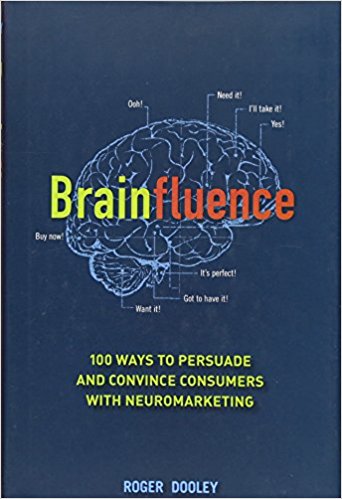
The most important thing in the book is that after reading it at least something remains useful. At least one tiny idea. After reading this, a lot of ideas for discussion are collected. Neuromarketing is now the most popular trend in marketing. In various laboratories around the world, consumers are placed into an MRI and see how their brains respond to these or other suggestions. Marketing is already heavily grounded in different scientific experiments on people which show people’s behavior and reaction in different situations.
The book explains how to adapt neuroscience and behavioral research to the goals of marketing and understand the patterns of making purchasing decisions. Neuromarketing studies brain reactions to various marketing incentives, both informational and sensory, in order to understand what customers are reacting to and why they make decisions. The book contains short and simple conclusions, offering basic strategies for working with customers in personal and online sales, using print advertising and other marketing tools. For a wide range of readers.
The Power of Habit

Now you will know exactly how to change your habits – how to make yourself eat less, go to the gym, do not smoke, do not get annoyed at close ones, work more effectively (what else do you have on the list?). It’s not easy but at the same time not fast. Charles Duhigg shows how a stiff habit is formed. What exactly in the “habit” makes you act like this, and not otherwise. And what does it mean to “have the will.” You can find the “cogs” of the usual way for you to act and twist them – to stay away from the usual reaction, feel like a master over yourself.
Did you know how to change the habit of a group of people? How, for example, have a whole country been taught to brush their teeth? Or that the formation of a habit in something insignificant – well, for example, to clean the bed in the morning – dramatically changes the way of life in general. This, by the way, also applies to business companies. The habit hinders, but the habit also saves. Just today, science knows about habits that half a century ago it was impossible to even think about.
Incredibly practical and intelligent book for the wide range of readers.
The Honest Truth About Dishonesty: How We Lie to Everyone
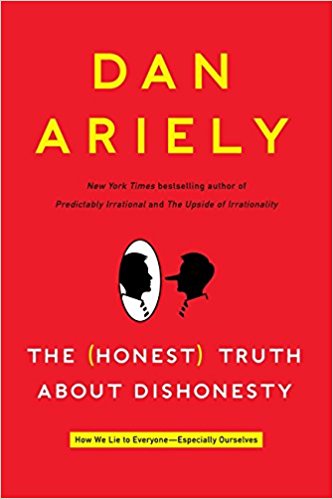
This book is capable of leading the reader to reflect on truth and lies, to challenge his previous ideas of honesty and to encourage him to look at himself without embellishment.
Most of us consider ourselves to be honest people, but in reality we all are liers. Examples of dishonest behavior can be found everywhere – in different cities, classrooms and workplaces. None of us has immunity against lies, whether it’s a “good lie for salvation” or petty frauds in travel expense reports. In the new book, Dan Arieli turns his inquisitive explorer-innovator to the topic of untruth.
The author’s arguments are based on the results of multiple psychological experiments. Despite the fact that the participants of the tests belonged to different cultures, it was possible to reveal only insignificant differences in their behavior, conditioned by national or state traditions.
The results and conclusions of these research will make everyone look at themselves “from the outside”, reflect on their ideas about truth and lies and, possibly, revise them.
The book is full of wonderful stories from life and fascinating scientific experiments, allowing to better understand the ethical principles of people and the motives of their behavior.
Everyone should read this book: both who is inclined to deceit, and who believes that he always tells the truth. It is useful for anyone who wants to know themselves and others better.
Numbers Rule Your World: The Hidden Influence of Probabilities and Statistics on Everything You Do

Pythagoras said: “All things can be represented in the form of numbers.” The numbers epitomized the region of the secret for the ancients. They were symbols of the harmony of the divine world. Ancient people believed that our life is governed by numbers. Particular importance was attached to the date of birth of a person, which determined his life path. After all, these digital combinations are nothing more than a secret information code, which, if correctly decoded, allows predicting human destiny. In this book author tells us the role of the numbers in the life of every one of us. The influence of statistics on our behavior and thoughts, interesting researches and examples, unique stories and not only can be found on the pages of this book which has achieved a great popularity among readers.
Made to Stick: Why Some Ideas Survive and Others Die

Do you want to spend your free time usefully? Then the book “Made to stick” is exactly what you need. With the help of it you can not only expand your knowledge, but also learn something new. The author of the book, Chip Heath, a man who knew what he was writing about, shows that the book was written not just to make money, but to be useful for every reader.
Every day there are hundreds of books, but among them there are only several options such that become bestsellers and deserve the respect of millions of readers around the world. “Made to stick” – is the book that is included to these “several options”. It opens our eyes to many things, inspires action and shows which direction to move. You probably think that a book of such themes can’t do this, but you are mistaken. To better understand everything that is written this book and decide whether it deserves your attention or not, I recommend reading the author’s foreword, in which Chip Heath will briefly introduce you to the contents of the book.
Chip Heath’s “Made to stick” is a book that is rapidly achieving popularity and I didn’t find any negative feedbacks in the Internet. I guarantee that you will not regret the time that you spend on reading it. If you are looking for the useful and interesting book, then I can congratulate you, the book “Made to stick” is exactly what you are looking for.
Fascinate: Your 7 Triggers to Persuasion and Captivation
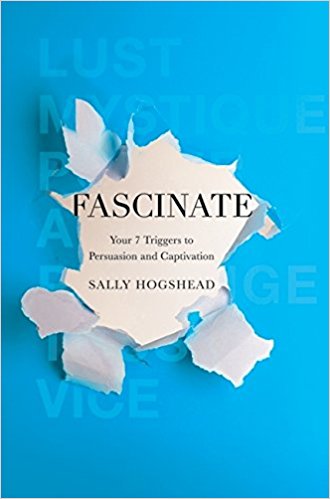
The ability to charm is the strongest and the most ancient way to influence people. Why you like some people, while others are not interesting at all? Why are some brands remembered and others are not? Why do some ideas influence you, as if, contrary to your will, you come under the influence of some ”sorcerous charms”, and others remain indifferent?
Since ancient times, the ability to charm was considered as a sorcery. The Romans considered it as a curse. The ancient Persians in Mesopotamia feared that fascination could cause a deadly disease, the Turks – that it leads to the evil eye. In the Renaissance, “enchanting” in one of the treatises was defined as an open covenant with Satan to influence others, in which enchanted people lost their will and mind.
In the twentieth century, fascination was compared to the hypnotic state. Freud compared it with a strong love, when a person loses critical abilities, falling into the “fetters of love.” But, according to Sally Hogshead, the ability to charm is not witchcraft or hypnosis. It is a tool, a science that can be learned. And at the same time, charm is a natural instinct that influences the behavior of others.
Often we buy food or drinks not because we are hungry or thirsty – we are simply fascinated by them. We control our lives much less than we think.
Predictably Irrational

People are used to think about themselves as not about perfect beings, but at least striving for perfection. Painters glorified the body, the poets bowed before the mind. This affected, in particular, the economy, which began to be based on a person’s ability to always make reasonable decisions in their favor. “The key idea of the economy is a rationality which forms the basis of many economic theories, forecasts and recommendations.” However, Arieli came to the conclusion that in reality our decisions are often irrational, moreover, they are predictably irrational. We act on the same unobvious scenarios. How and why do we evaluate what we have? Why would a tablet that costs five dollars help us more than one that costs five cents? Why, when dealing with cash, do people act more honestly? How do we overpay for nothing? If we manage to understand the motives of our actions – and this book will become a great help in this case – this will certainly have a beneficial effect on our future behavior. Understanding your own non-ideality will give us a lot of practical advantages.
Drive: The Surprising Truth About What Motivates Us

Many managers are sure that the best way to motivate an employee to high results is money reward, that are bonuses for the result or other “gingerbread”. After all, people do work for money, and the practice of “do A and I’ll give you B” has become almost a classic of management.
It turns out that not everything is so simple. In his provocative bestseller, Daniel Pink convincingly proves that in the information age the motivation system, based only on reward for achieving the result, has become not only useless, but in some cases directly damages both employees and the company.
But how then do you motivate staff to achieve their goals and defeat their competitors? It is necessary to emphasize the natural aspiration of each person for excellence, mastery and independence, and hire only those people who have strong internal motivation. It is not as difficult as it may seem, in the book you will find simple and understandable tools for building a new motivation system.
This book is worth your attention because this is one of the most important book about motivation written in the world in recent years. The book fundamentally changes our perception of the factors that affect the results of work, the motivation for work, for creativity. The author reinforces all his thoughts with more than convincing results of hundreds of psychological studies on people’s behavior.
The second half of the book is very practical – the author gives many tools and methods for creating a new system of motivation. This is the unique blend of humanistic psychology and real management practice! The book will be interesting to the managers of organizations, as well as to specialists in personnel management.
Stumbling on Happiness
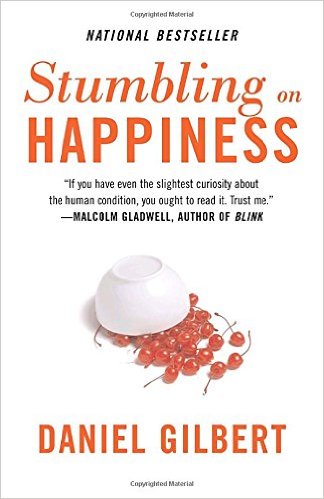
People spend a lot of efforts, energy and resources to make themselves happy in the future: for decades enter into a mortgage, dreaming of their own housing, take loans at high interest rates to live comfortably in a renovated house, make a career, working over at work, to ever earn for all the blessings of life. But in the pursuit of the future, we forget that we can and should be happy in the present. In his remarkable and witty book, which for tens of thousands of people around the world has become a real guide to action, the well-known Harvard psychologist Daniel Gilbert talks about why our predictions of one’s own happiness in the future do not coincide with reality. Based on theories and facts from psychology, cognitive neurology, philosophy and behavioral economics, the author proves to us that happiness needs to be created in the present!
Priceless: The Myth of Fair Value

Is it expensive or cheap? And why sometimes we think about it when buying, and sometimes it just does not matter? William Poundstone talks about the psychology of prices, how smartly the psychological tricks of marketing are used and how the “right” figure should look on the price tag. In order to the consumer buy this stuff. Buy at any price. The current book is based on the behavioral theory of decision making, the formation and development of which was largely contributed by Daniel Kahneman and Amos Tversky. This book will be interesting (and very useful) for everyone who buys, sells or negotiates.
The Art of Choosing
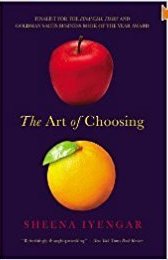
Iyengar’s book makes everyone of us think about what place choice occupies in our life. We make choices, and choices make us. How do we choose to make decisions?
We just think that we are so different and unique, but in fact we have a lot in common. Especially it concerns the way we take decisions. Does the variety of alternatives always lead to a better result? How can a person, knowing the peculiarities of the work of his brain, manage the process of his choice? How can companies use decision-making features to increase profits? Although the choice is difficult, you don’t need to fear it, but to approach decision-making, armed with knowledge. The book provides us with the tools of analysis. It touches on a multitude of philosophical and existential questions, the problems of self-determination, interrelations in society, individualism and collectivism, leadership, vitality, pedagogy, upbringing, marketing and investment. All these problems are connected by a single thread – a choice from a variety of alternatives. But most importantly – the book makes you stop and think, re-examine your life goals, priorities and values.
The problem of choice has been studied for a long time with the help of various approaches to its analysis. The psychology-based approach that the author applies, explains the decision-making process in business, economics, biology, philosophy, medicine, social sciences and politics.
Switch: How to Change Things When Change is Hard
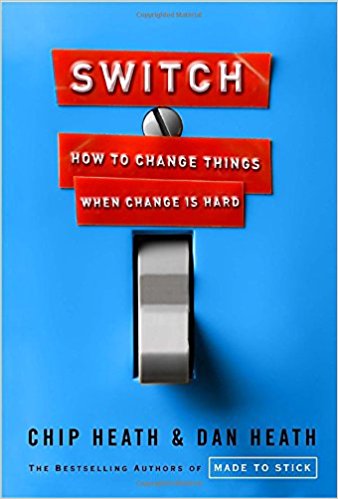
Why is it so difficult to achieve long-term changes in companies, communities and in personal life?
The main obstacle to constructive change is the conflict between rational and emotional thinking. The rational part of our brain wants a beautiful body for the beach season, and the emotional part wants to eat one more biscuit. The rational part wants constructive changes at work, and the emotional part is content with the comfort of the existing routine. This conflict can ruin all attempts to achieve changes.
In this book, the Heath brothers, the best-selling authors of the “Thinking Traps,” show how a wide variety of people – professionals and managers, parents and nurses – reconcile internal contradictions and achieve outstanding results. Among the heroes of the book are medical interns who have achieved a change in practice that has been established over decades, which has been dangerous for patients; a housekeeping guru who was able to develop a simple technique that helps overcome fear and unwillingness to lead a household; a manager who turned negligent customer support into real service fans, abandoning traditional tools.
The study, based on the latest developments in psychology, sociology and other sciences, clearly shows that successful changes are not accidental, but on specific patterns. After reading this book, you can change for the better your life and the world around you.
Thinking, Fast and Slow

Our actions and behaviour are determined by our thoughts. But do we always control our thinking? Nobel laureate Daniel Kahneman explains why we sometimes do irrational actions and how we make wrong decisions. We have two systems of thinking. “Slow” thinking is included when we solve a problem or choose a product in the store. Usually it seems to us that we confidently control these processes, but let’s not forget that behind our consciousness in the background “fast” thinking is constantly working – automatic, instant and unconscious …
Yes! 50 Scientifically Proven Ways to be Persuasive

It is generally accepted that psychology is intuitively understood by any sensible person, and therefore it is not worth studying it separately. A great misconception! The authors of this book argue that anyone who studies persuasion strategies from a scientific point of view can significantly more effectively convince others and build relationships with other people. It is the scientific basis that allows, by changing very little, to obtain striking results in the field of effective communication and influence on people. The book will teach you how to deal with the most difficult task easily: honestly, ethically and correctly build relationships with other people.
Each of us had to face the fact that our demands are not met, requests are not heard, and wishes are not taken into account. Why is this happening and how to act in such situations? The answers to these questions can be found on the pages of the book.
This book is for all those who need to be persuasive: at work or at home, with intimate or unfamiliar people, with verbal treatment or writing. This is a real encyclopedia of persuasion, a series of effective and ethical techniques for all occasions!
In the book there are 50 interesting articles – 50 receptions in a piggy bank of your persuasion skills. Each of the described methods is not only scientifically proven, but also repeatedly confirmed in practice.
Influence: Science and Practice

This book is one of the best teaching aids in social psychology, conflictology and management, according to most psychologists all over the world. The book by Robert Chaldini has withstood five editions in the US, its edition has exceeded two million copies.
This work, which bribes the reader with an easy style and effective presentation of material, is a serious work in which the main mechanisms of motivation, assimilation of information and decision-making are analyzed at the modern level.
New, revised and supplemented, the publication of the international bestseller will take a worthy place in the library of a psychologist, manager, teacher, politician – everyone who, by the nature of his activity, must persuade, manipulate and influence.
The Social Animal

This book is the newest expanded and supplemented edition of one of the best modern textbooks on social psychology – the science of human behavior in society. Knowledge of the laws of social psychology allows us to understand the causes of actions, thoughts and emotions of other people; Learn how you can influence a person and avoid influence; To understand what mechanisms are at the heart of the development of society and what should be done so that society flourishes. The main advantage of this book is that one of the patriarchs of this science and one of the leading present scientists of this area – Elliot Aronson will acquaint you with researches, conclusions, theories, hypotheses, experiments and laws of social psychology. Reading a book will give you special pleasure: from the most interesting material – on the one hand, and from the perfection of its presentation – on the other.

